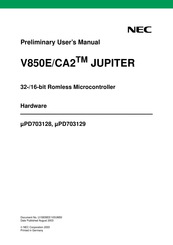NEC V850E/CA2 JUPITER Manuals
Manuals and User Guides for NEC V850E/CA2 JUPITER. We have 1 NEC V850E/CA2 JUPITER manual available for free PDF download: Preliminary User's Manual
NEC V850E/CA2 JUPITER Preliminary User's Manual (612 pages)
32-/16-bit Romless Microcontroller
Brand: NEC
|
Category: Microcontrollers
|
Size: 7.81 MB
Table of Contents
-
Preface5
-
-
-
Features
55 -
-
Memory Map
68-
-
Area70
-
-
-
-
-
Features
109 -
Bus Control Pins
109 -
Bus Access
116 -
-
Bus Width119
-
-
Wait Function
131 -
-
Program Space136
-
Data Space136
-
-
-
-
-
Features145
-
On-Page/Off147
-
Page ROM Access150
-
-
-
Features
155 -
Configuration
156
-
-
-
Features
169 -
-
DMA Bus States
184 -
Transfer Mode
187 -
Transfer Types
193 -
Transfer Object
193 -
Precautions
198
-
-
-
Features
199 -
-
-
-
-
Analog Filter222
-
-
Exception Trap
230
-
-
-
Features
239 -
Configuration
240 -
-
-
General251
-
HALT Mode256
-
IDLE Mode258
-
WATCH Mode259
-
SUB WATCH Mode261
-
-
-
Chapter 10 Timer
271-
Timer C
271-
Operation283
-
Timer D
296-
Features Timer D296
-
Control Register301
-
Operation302
-
-
Timer G
306
-
-
-
Function
349 -
Configuration
350 -
Operations
352
-
-
-
Functions
357 -
Configuration
358 -
Operation
362
-
-
-
Features
363 -
-
Features364
-
Configuration365
-
Operation375
-
Precautions391
-
-
-
Features392
-
Configuration393
-
Operation408
-
Output Pins422
-
-
-
-
Features
427 -
-
General428
-
Clock Structure438
-
Time Stamp441
-
Message Handling443
-
Mask Handling448
-
-
-
Common Registers454
-
-
-
-
-
Features
523 -
Configuration
524 -
-
-
Operation Modes538
-
-
-
Chapter 17 RESET
583-
Reset Overview
583 -
Features
583 -
Pin Functions
583 -
Reset Output
587 -
Initialization
588
-
-
-
Appendix B Index
601
Advertisement
Advertisement
